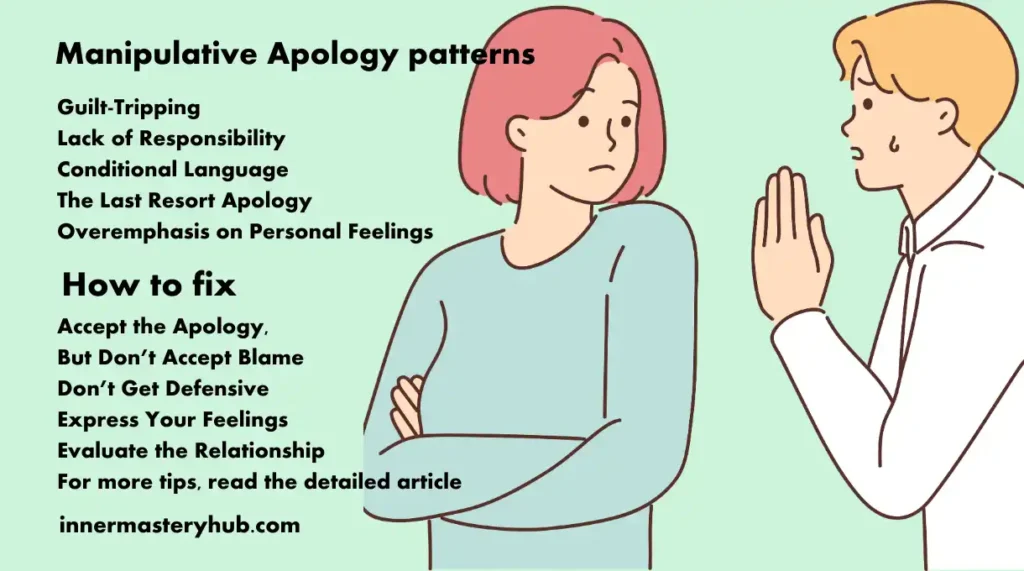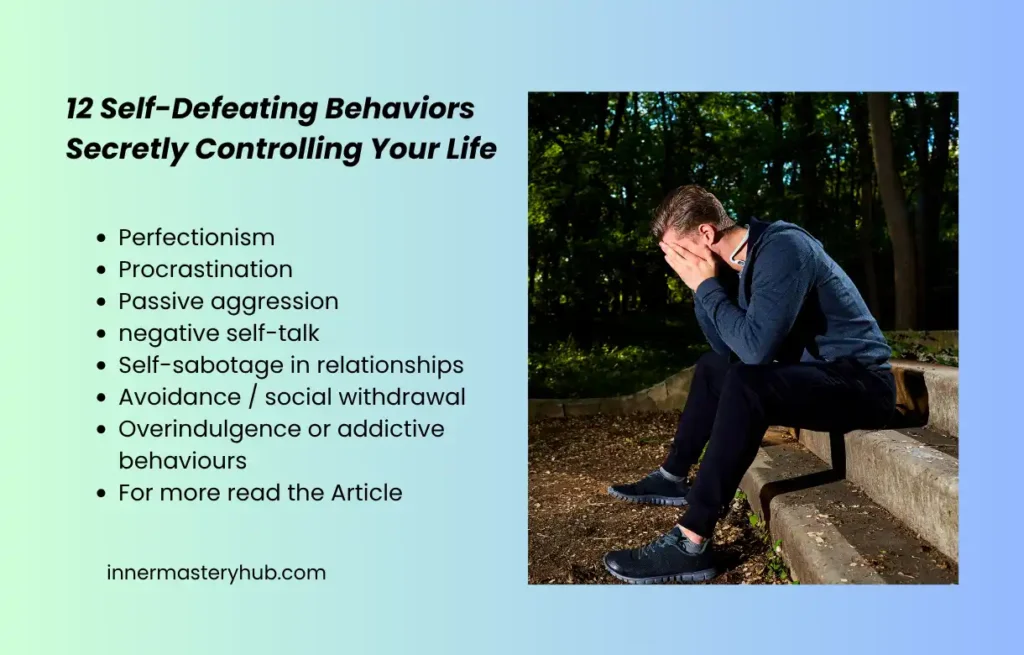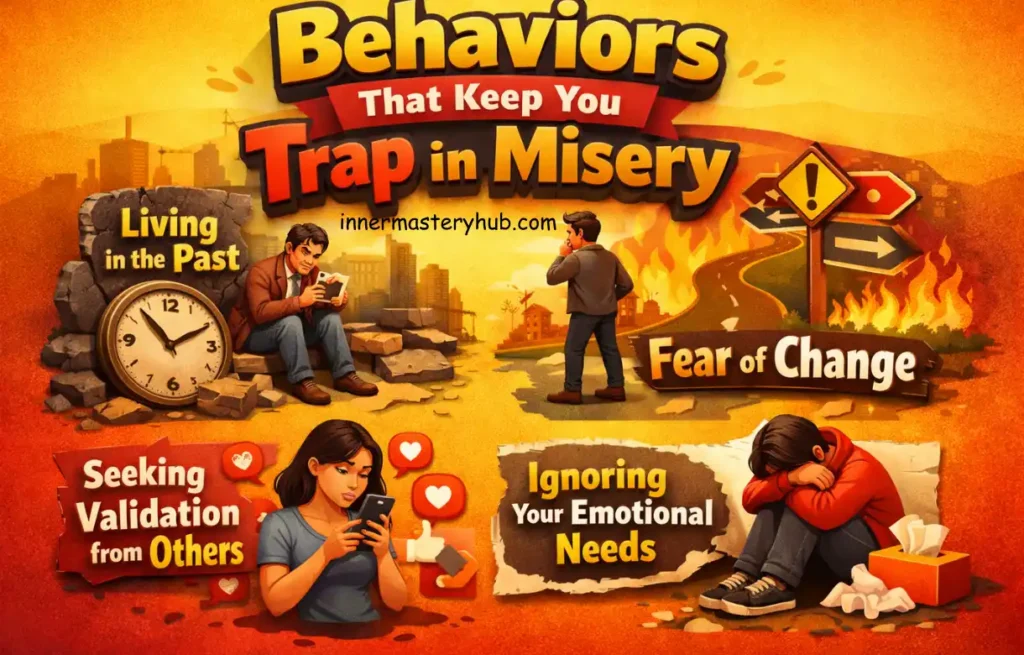11 Ways to Respond Effectively to Manipulative Apology Patterns

For years, apologies have healed relationships. You need to correct mistakes to restore trust. However, not all apologies are healing, but some can be manipulative. People might use apologies to dodge responsibility and change the story. Identifying manipulative apology patterns can help you avoid emotional harm. How manipulative apologies affect you and how to handle them
Identifying Manipulative Apology Patterns
Complex apologies have an objective. These apologies blamefully shift Blame, incite guilt, or downplay the offence in question.
Lack of Accountability
Avoiding Blame is common when it comes to deceptive apologies. When Someone says “I’m sorry you feel that way” or “I’m sorry if you were offended,” instead of apologizing. These expressions focus on how the other person feels rather than the harm done.
When Someone who forgets your birthday may say, “I’m sorry if you were upset,” or “I’m sorry you took it personally.” This blames you for being offended rather than realizing they skipped your special day. These excuses make it seem like the culprit is acknowledging your feelings but not their actions. Unlike a sincere apology, it doesn’t accept the real issue.
2. Conditional Language
Conditional wording is another manipulative apology method. Suppose Someone uses “but” or “if,” this means that they’re not taking responsibility. They may say, “I’m sorry, but I was under a lot of stress,” or “I’m sorry if I upset you, but I didn’t mean to.” This eliminates the mistake that was made. Instead of taking on full responsibility, the apology depends on the other person’s response to the misunderstanding.
Conditional apologies sometimes rationalize misconduct with an excuse. “I’m sorry if you misunderstood me” shifts blame from the apologizer to the sufferer. The person apologizes as if a miscommunication or external circumstance caused the incident, not as if they did something wrong.
In these instances, the person’s behavior is justified or minimized, and the apology becomes about the victim’s perception, not the perpetrator’s actions.
3. Overemphasis on Personal Feelings
A deceptive apology is all about concentrating too much on the apologizer’s feelings rather than the hurt they caused. Many say, “I’m really sorry; I feel terrible about this.” Though seeming to admit responsibility, this redirects the attention from the victim to the apologizer.
This strategy makes the apology on the apologizer’s feelings rather than the recipient’s. The other person feels justifiable in their behavior since they are “feeling bad.” Though expressing emotions is necessary, an apology that highlights personal feelings usually insists on the person apologizing’s pain rather than the harm done.
In these kinds of situations, an apology should address the wrongdoer’s impact, not merely their feelings. True remorse requires grasping the damage, not just soothing yourself.
4. Guilt-Tripping
Manipulative apologies make victims feel guilty about their emotions, which they call “guilt-tripping.” Manipulators can reply with “Sorry you’re angry. You’re overreacting,” or “I didn’t mean to hurt you.”
This apology controls the victim’s emotions rather than taking responsibility. The goal is to make the victim feel overreacting. After apologizing, the conversation moves to the other person’s emotions. The victim feels guilty for being upset and questions whether their feelings are valid.
Guilt-tripping makes it tough to trust your emotions, causing you to question whether you’re overreacting or not.
5. The Last Resort Apology
When the manipulator is exposed in a falsehood or has run out of other options, they typically provide a last-resort apology. These regrets are too late, frequently after the manipulator has refused Accountability for an extended period. A very brief, superficial “I’m sorry” may be offered to conclude the conversation or to make things more amicable.
Often, this type of apology fails to make a genuine effort. Without addressing the underlying problems or the harm done, it’s an effort to put an end to a situation. When the manipulator says, “I’m sorry, but let’s move on,” they are trying to avoid dealing with the issue.
The Emotional Impact
Manipulative apologies are intended not for healing or resolving the matter at hand; instead, they serve to conclude the uncomfortable interaction. This kind of apology does no help in the development of the relationship and can leave the victim with the impression that their concerns have been ignored.
How Manipulative Apologies Erode Trust and Self-Esteem

Manipulative apologies change the truth. They create a context where the victim feels their emotions are not valid. This can weaken trust in the other person and create uncertainty about the victim’s emotional responses.
When these types of apologies become a recurring theme, it can lead the victim to doubt themselves. Over time, the individual may feel that they can never achieve closure or understanding from the manipulator, as the person is never completely responsible.
The emotional confusion that results from manipulative apologies can be harmful in relationships, whether they are personal or professional. The victim feels alone or even emotionally mistreated because they are always trying to validate their feelings or the situation.
Life Examples
friendship. “I’m sorry you’re angry about it,” a friend replies instead of truly expressing regret for forgetting your birthday. I didn’t think it was a big deal. Here, your response is more important than their forgetting.
At work. A coworker keeps claiming credit for your concepts. “I regret if you felt that I stole your concept, but I was merely contributing to the effort,” they respond when confronted. This manipulative apology pattern shifts the Blame from the fact that they took something that wasn’t theirs to your opinion.
Family. A parent promises to attend a significant event but cancels at the last minute. They say, “I’m sorry, I know this is upsetting, but I have so much going on right now. It’s just too hard to keep promises.” This shifts the focus onto their own difficulties, making you feel guilty for being upset.
These examples show how manipulative apologies are more about deflecting responsibility than addressing the issue at hand.
How to Respond Effectively when you see manipulative apology patterns
Identifying a manipulative apology pattern is the first step. The next step is learning how to respond in a way that protects your emotions and sets boundaries.
1. Accept the Apology, Don’t Accept Blame
To identify a manipulative apology pattern is necessary, even if you don’t see it. This reflects your awareness of the situation, but it doesn’t mean that you support the fabricated Blame or accept Blame. You could respond with something like, “I think the problem isn’t being handled properly, but I understand what you’re saying.
Their attempt at an apology is accepted in this response, but it does not release them. It protects your stance and permits an honest discussion to arrive at a resolution.
2. Express Your Feelings Clearly
It is completely within your rights to voice your feelings on the manipulative apology behaviors. “I feel like this apology doesn’t fully recognize what happened,” or “I don’t feel heard when the blame is shifted onto me,” are tough statements to make. Communicate your feelings about their behavior, and you allow the other person to understand the consequences of their actions easily.
3. Set Clear Boundaries
In any relationship, it’s necessary to set boundaries, especially when dealing with manipulative behaviors. Tell Someone what is and isn’t right if they keep making apologies. When you’re able to say, “I need a direct statement of what happened, not an apology that shifts blame or focuses on my feelings.”
You can reduce the possibility of manipulative behavior by defining boundaries. It could be time to reassess the partnership if the other person disregards those boundaries.
4. Evaluate the Relationship
The relationship may need to be evaluated if manipulative apology behaviors continue. Trust and Accountability are the basis of a healthy partnership. It may be time to put some distance between you and your emotional health if these factors are consistently absent.
5. Remain Calm and Avoid Getting Offended
To trigger an emotional response, manipulative apologies are used. You can try to avoid getting into a defensive argument and maintain your composure. Take a breath deeply and try not to defend your own behavior. When responding, be composed and grounded.
6. Call Out the Manipulation Gently
The manipulation can be addressed politely and directly. “I see you’re apologizing for how I feel, but not for what actually happened,” for example. Observe the activity, not simply my feelings, is vital.
6. Refrain from Playing Blame Games
Avoid getting pulled into a blame game. False apologies attempt to twist the facts to their advantage. Rather than being caught in Blame, concentrate on the particular action or situation. “Let’s concentrate on the actions that caused this issue,” you may say.
7. Encourage Accountability
Push those responsible to accept ownership for what they have done. To truly apologize, one must accept complete responsibility. Try saying, “I need to hear that you understand what you did wrong and why it affected me the way it did.”
8. Request a Specified Adjustment
You never have to accept an apology without requesting concrete behavioral adjustments. A sincere apology should be coupled with an intention to improve. “I need to know how you plan to avoid repeating this in the future,” you could add. How are you going to ensure that this doesn’t happen again?
9. Take Time to Process the Situation
Give yourself some time to think things through if the deceptive apology leaves you feeling unclear or puzzled. You are not required to reply right away. “I need some time to think about this and get back to you later,” is a completely acceptable response.
10. Examine the Relationship’s Future Course
The relationship may need to be reviewed if the manipulative apology pattern persists. Are you being manipulated all the time? If so, break up with the person or get expert advice to determine if it’s worthwhile to keep the relationship going.
Conclusion
Because manipulative apology patterns avoid Accountability and concentrate on shifting Blame, they are detrimental. Being aware of these patterns of apologies can help you guard against emotional manipulation.
Response to manipulative apology patterns helps you to create distinct boundaries, recognize the apology, and properly communicate your feelings. This will, over time, support you in keeping relationships that are more balanced and healthy.
A sincere apology needs to take responsibility, express regret, and offer compensation. Less is a strategy to control the circumstances and escape responsibility. These circumstances can be handled with confidence and emotional resilience if you remain clear and dedicated in your responses.
Frequently Asked Questions (FAQs) on Manipulative Apology Patterns
What defines a manipulative apology pattern?
A manipulative apology avoids Accountability, often using phrases like “I’m sorry if you feel that way. ” Blame shifts blame onto the recipient.
What defines a manipulative apology pattern?
A manipulative apology pattern avoids Accountability, often using phrases like “I’m sorry if you feel that way. ” Blame shifts blame onto the recipient.
How can I identify a manipulative apology pattern?
Look for conditional language, lack of responsibility, overemphasis on the apologizer’s feelings, guilt-tripping, or using apologies to end conversations without addressing the issue.
Why do people show manipulative apology patterns?
Individuals may use manipulative apologies to avoid conflict, maintain control, or evade genuine Accountability for their actions.
What are examples of manipulative apology patterns?
Examples include “I’m sorry you feel that way,” “I didn’t mean to upset you, but you did this,” or “I apologize if you misunderstood me.”
How should I respond to a manipulative apology pattern?
Recognize the manipulative apology pattern, express how it makes you feel, set clear boundaries, and communicate your expectations for future behavior.
Can a manipulative apology pattern damage relationships?
Yes, repeated manipulative apologies can erode trust, create emotional confusion, and damage the foundation of relationships.
What is the difference between a genuine and a manipulative apology pattern?
A genuine apology acknowledges wrongdoing, expresses remorse, and seeks to make amends, while a manipulative apology deflects Blame and avoids responsibility.
Are manipulative apology patterns common?
Yes, studies suggest that a significant percentage of people have encountered manipulative apologies in various relationships.
How can I protect myself from manipulative apology patterns?
By recognizing the signs, setting firm boundaries, and seeking support from trusted individuals or professionals when needed.
Is it possible to rebuild trust after a manipulative apology pattern?
Rebuilding trust is challenging but possible if the individual demonstrates genuine remorse, takes responsibility, and makes consistent efforts to change.






